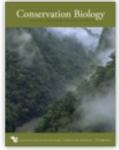Potential Effects of the United States-Mexico Border Fence on Wildlife
Featured in Conservation Biology's 2010 International Year of Biodiversity: Connectivity and Corridors (virtual issue).
Security infrastructure along international boundaries threatens to degrade connectivity for wildlife. To explore potential effects of a fence under construction along the U.S.–Mexico border on wildlife, we assessed movement behavior of two species with different life histories whose regional persistence may depend on transboundary movements. We used radiotelemetry to assess how vegetation and landscape structure affect flight and natal dispersal behaviors of Ferruginous Pygmy-Owls (Glaucidium brasilianum), and satellite telemetry, gene-flow estimates, and least-cost path models to assess movement behavior and interpopulation connectivity of desert bighorn sheep (Ovis canadensis mexicana). Flight height of Pygmy-Owls averaged only 1.4 m (SE 0.1) above ground, and only 23% of flights exceeded 4 m. Juvenile Pygmy-Owls dispersed at slower speeds, changed direction more, and had lower colonization success in landscapes with larger vegetation openings or higher levels of disturbance (p ≤ 0.047), which suggests large vegetation gaps coupled with tall fences may limit transboundary movements. Female bighorn sheep crossed valleys up to 4.9 km wide, and microsatellite analyses indicated relatively high levels of gene flow and migration (95% CI for FST = 0.010–0.115, Nm = 1.9–24.8, M = 10.4–15.4) between populations divided by an 11-km valley. Models of gene flow based on regional topography and movement barriers suggested that nine populations of bighorn sheep in northwestern Sonora are linked by dispersal with those in neighboring Arizona. Disruption of transboundary movement corridors by impermeable fencing would isolate some populations on the Arizona side. Connectivity for other species with similar movement abilities and spatial distributions may be affected by border development, yet mitigation strategies could address needs of wildlife and humans.

